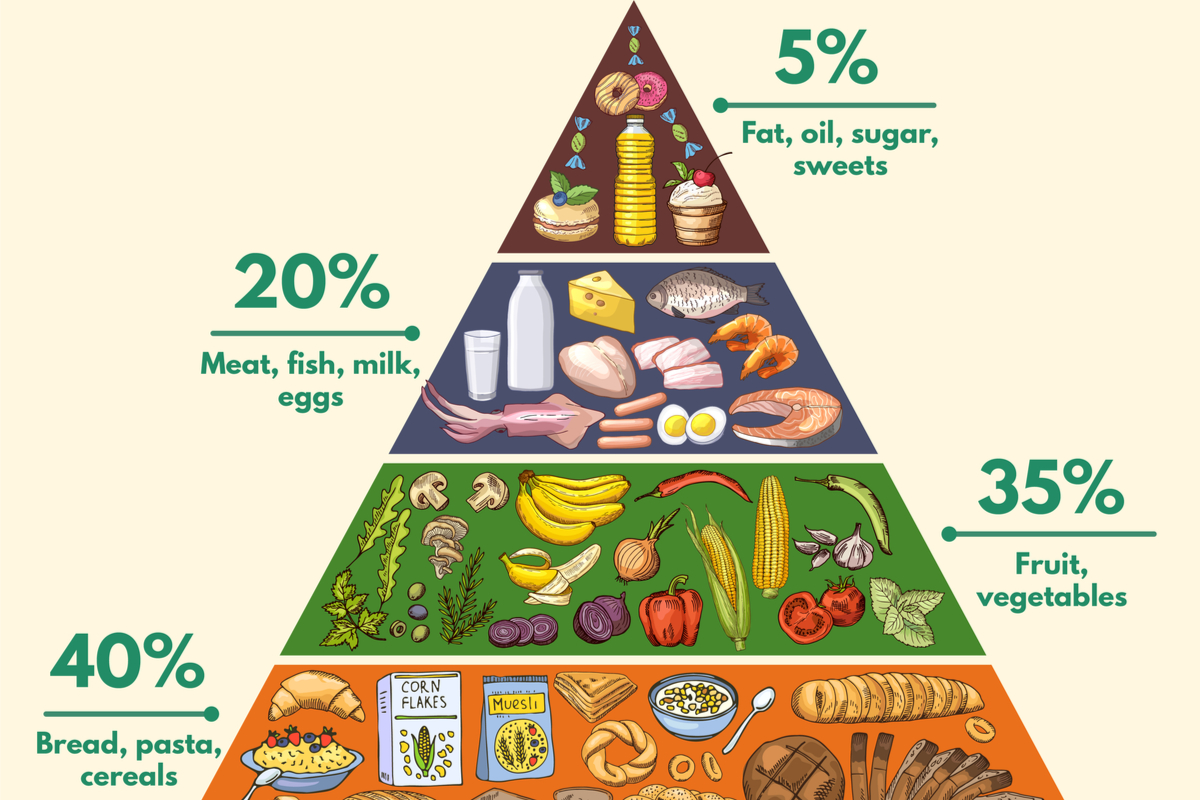It really amazes me that the amount of information we are able to access with the touch of a screen, it is so liberating.
Especially in the present day world, where nothing is more certain than the lack of time on our hands. Jobs, children, family and social obligations often leave us eating out, eating rich food or junk food.
It is hard to keep it together but if we manage to get in these power foods at least once a week, you will beat the odds of ill health and bypass the lack of nutrients in the long run.
The food pyramid recommends food-serving sizes.
A very easy to understand chart of food, daily recommendation and its serving sizes for each food group is given below; (Stanford Healthcare)
BREAD, CEREAL, RICE & PASTA GROUP (6-11 servings a day recommended)
A serving is:
- 1 slice of bread
- 1 oz of ready-to-eat cereal
- 1/2 cup cooked pasta
- 1/3 cup rice
- 1/2 cup cooked cereal (oatmeal, cream of wheat, grits)
- 4-6 crackers
FRUIT GROUP (2-4 servings a day recommended)
A serving of fruit is:
- 1 medium-sized fruit, such as an apple, orange, banana, or pear
- 1/2 cup of raw, cooked, canned, or frozen fruits
- 3/4 cup (6 oz) of 100 percent fruit juice
- 1/4 cup dried fruit, like raisins, apricots, or mango
VEGETABLE GROUP (3-5 servings a day recommended)
A serving of vegetables is:
- 1 cup of raw (carrots, broccoli) or leafy vegetables (i.e., lettuce, spinach)
- 1/2 cup cooked garden vegetables
- 3/4 cup of vegetable juice
MILK, YOGURT & CHEESE GROUP (2-3 servings a day recommended)
For dairy products and recipes that use them, choose skim or 1 percent milk and soft cheeses such as Cottage, Ricotta, Mozzarella, Parmesan and Neufchatel. These have less saturated fat, which can clog your arteries.
A serving of dairy foods is:
- 1 cup of milk
- 1 cup unflavored yogurt
- 1 1/2 oz of natural cheese or 2 oz processed cheese
- 1/2 cup of ice cream or ice milk
MEAT, POULTRY, FISH, DRY BEANS, EGGS & NUTS GROUP (2-3 servings or 6-9 oz a day recommended)
One serving of meat or meat substitute is 3 oz of chicken, beef, pork, fish, or veggie burger. An easy way to judge a meat portion is to remember that a 3-oz portion is the size of a full deck of cards or a woman’s palm.
If you eat red meat, choose lean cuts such as round, sirloin and flank. Because these have less fat, they are tough cuts and will benefit from being marinated or cooked with a liquid in a crockpot to make them more tender. Keep portions to the size of a deck of cards. Moderate portions of meat will leave more space on your plate for cancer fighting fruits, vegetables, and grains.
One ounce of meat or meat substitute is:
- 1/2 cup cooked or canned legumes (beans and peas)
- 1 egg
- 3/4 cup of nuts (small handful)
- 2 tablespoons of peanut butter
FATS, OILS & SWEETS
(Fats and sweets should be eaten sparingly. They are high in calories and fat.)
A serving of fat is:
- 1 teaspoon of oil or regular mayonnaise
- 1 tablespoon of light mayonnaise
- 1 tablespoon of regular or 2 tablespoons of light salad dressing
- 2 tablespoons of sour cream
- 1 strip of bacon
A serving of sweets is:
- 1 3-inch cookie
- 1 plain doughnut
- 4 chocolate kisses
- 1 teaspoon of sugar or honey
With this understanding of food groups and portion control,
Here’s a list of super foods you should eat at least once a week.
Dark Chocolate– flavanols, it protects your body from skin damage and internal inflammations.
Asparagus- vitamin B12 and folate.
Avacado- cholesterol-lowering powers.
Carrots– beta-carotene.
Goji berries- can eradicate tumors and improve your immune system.
Green tea– contains many kinds of antioxidants. Avoid mixing tea with milk.
Lean red meat– protein and loads of zinc.
Lentils- protein source also help in calcium absorption.
Peanut Butter– very low glycemic index, neutralizes the effects of carbohydrates, ideal for diabetics.
Salmon- low in calories, high in protein and source of vitamin B and omega-3 fatty acids.
Sardines- Selenium – an important micronutrient that preserves liver health.
Sunflower seeds – Magnesium.
Tofu- soy protein includes all the essential amino acids.
Tomato Juice– Lycopene, important for our bodies’ immune system.
Yoghurt– dairy product is full of calcium, potassium, and probiotics – healthy bacteria that form our intestinal flora.
Flaxseeds– Omega-3 fatty acids
Pumpkin– antioxidants and micronutrients.
Quinoa- entirely plant-based and high in protein, a rare food that contain all nine essential amino acids.
Berries- A fiber-filled super fruit.
Eggs- Lutein and Zeaxanthin; two very powerful compounds to increase muscle volume and improve eyesight.
Beans-Iron.
Nuts– Different kinds of nuts will bring different kinds of benefits.
Oranges– Vitamin C.
Sweet Potato– Alpha and beta-carotene are diverted into vitamin A, which helps your vision.
Broccoli– Low in calories and high in vitamins A and C.
Spinach– vitamins A, C, and K.
Include these once a week in your diet to enjoy the benefits of healthy living.



